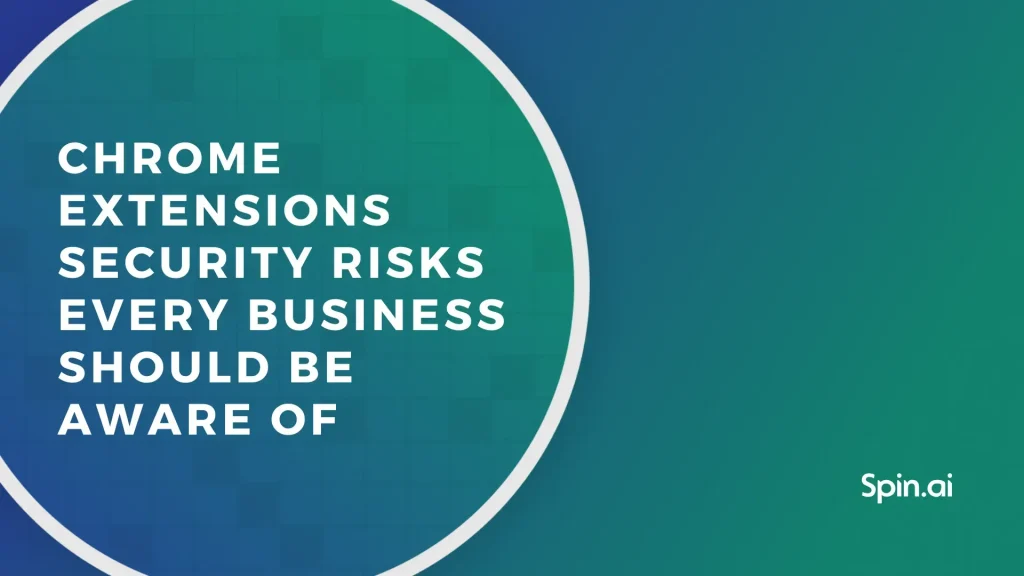When it comes to Chrome extensions security risks, users must be increasingly vigilant. These little add-ons can transform your browsing experience but harbor potential dangers, especially if they are suspicious Chrome extensions or malicious browser extensions that compromise your privacy. Reports have uncovered numerous harmful extensions that exploit user data and request unnecessary permissions, raising significant concerns about browser extension safety. As a result, understanding the privacy risks of extensions is crucial in today’s digital landscape, where a simple click can lead to unwanted data breaches. If you suspect your browser is compromised, it’s essential to know how to efficiently remove Chrome extensions and secure your personal information.
Navigating the world of browser tools demands an acute awareness of the associated security threats. In examining the landscape of add-ons, one must consider the implications of installing potentially harmful tools that promise enhanced functionality. The prevalence of deceptive applications that pose as helpful features can have dire consequences for your online privacy and safety. With increasing reports of extension-related vulnerabilities, it is vital to investigate the integrity of these tools before integrating them into your browsing experience. A well-informed approach to managing your add-ons can significantly reduce the risks associated with unwanted data collection and unauthorized access.
Understanding the Chrome Extensions Security Risks
Browser extensions are often heralded as productivity boosters in the digital age, but they can also introduce significant security risks. The rise of malicious browser extensions underscores the need for users to exercise caution when installing these tools. Recently, 35 suspicious Chrome extensions were identified, raising alarms about potential privacy risks and safety concerns. These extensions, which have been installed millions of times, often request unnecessary permissions and can monitor users’ online activities without their consent.
The extent of access granted to these extensions can be alarming. Many can read tabs, manage cookies, and even intercept web traffic. This level of permission allows them to collect sensitive information, effectively functioning as spyware. Without proper oversight, users may unknowingly expose their personal data to third parties. It is crucial for users to familiarize themselves with these security risks before installing any Chrome extensions to mitigate privacy breaches.
The Dangers of Suspicious Chrome Extensions
Unfortunately, not all Chrome extensions serve a legitimate purpose; some are designed with malicious intent. Investigations have uncovered that several extensions, touted as security or productivity tools, are actually capable of serious privacy violations. Users are lured in by the promise of enhanced functionality, only to later discover that these suspicious extensions are tracking their online behavior and sharing data with unknown entities.
Moreover, the challenge lies in identifying which extensions are truly safe. The list of malicious browser extensions continues to grow, leading experts to recommend that users maintain vigilance. Before installation, users should meticulously review extension permissions and seek out trusted sources of information. Promptly removing any suspicious Chrome extensions can prevent potential data breaches and maintain browser safety.
Best Practices for Browser Extension Safety
Ensuring browser extension safety begins with adopting best practices that protect both user privacy and data integrity. Users should be proactive about their browser security by regularly updating their browsers and extensions. Updates not only introduce new features but also patch security vulnerabilities that malicious actors exploit.
Additionally, only install extensions from reputable developers or trusted stores. Utilizing strong antivirus software can add an extra layer of protection, alerting users to potentially harmful extensions before they are installed. Remaining skeptical of any extensions that request excessive permissions is another key strategy; if an extension demands access that seems disproportionate to its functionality, it’s wise to avoid it.
How to Remove Malicious Chrome Extensions
If you’ve installed suspicious Chrome extensions, it’s crucial to remove them immediately to protect your privacy and data. The removal process is straightforward but often overlooked. Start by clicking the puzzle piece icon in Chrome’s toolbar, which displays all your active extensions. Identify any extensions that appear unfamiliar or unnecessary.
After pinpointing the extensions you’d like to remove, click the three-dot icon next to each extension and select ‘Remove from Chrome.’ Confirm your choice by clicking ‘Remove.’ Regularly cleaning up your browser can prevent potential security breaches and ensure a safer online experience.
The Importance of Reporting Malicious Extensions
Reporting malicious extensions is an important step in enhancing overall browser security. Users who encounter suspicious Chrome extensions should not only remove them but also report them to the developers and relevant authorities. By doing so, users can contribute to the collective effort to identify and eliminate potential threats from the extension ecosystem.
Moreover, reporting can help raise awareness about particular extensions and their harmful behaviors, potentially protecting other users. Collaborative efforts between users and browser developers can fortify security measures and foster a safer online environment for everyone.
Evaluating Google’s Role in Browser Extension Security
Google, as the provider of Chrome, bears significant responsibility for maintaining a secure browsing environment. A recent incident involving malicious extensions that bore Google’s ‘Featured’ badge raises questions about the integrity of the vetting process. Users expect that any extension listed in the Chrome Web Store has been extensively reviewed for safety and usability.
The presence of dubious extensions among the so-called trusted ones highlights the need for improved accountability on platform providers. Users deserve assurance that extensions on official stores are thoroughly evaluated, thus preventing the inadvertent installation of spyware and other concerning tools.
User Awareness: Protecting Privacy with Browser Extensions
User awareness plays a pivotal role in maintaining privacy when using browser extensions. Knowledge about the permissions requested by extensions and understanding their purposes can significantly reduce risks. Users should remain mindful of the permissions being granted, especially if an extension is requesting access to sensitive information or browsing data.
Educating oneself about the potential dangers of extensions can empower users to make informed decisions. By being aware of common red flags in extension descriptions or reviews, individuals can protect their privacy and enhance their overall online safety.
The Future of Safe Browsing and Extensions
As technology continues to evolve, so do the tactics employed by malicious actors in the browser extension realm. Future safety measures will likely focus on improving cross-platform collaboration to establish robust security standards for browser extensions. These standards could include stricter evaluation processes and ongoing monitoring of installed extensions for malicious behavior.
Furthermore, educating users about emerging threats and safe browsing practices will remain essential. As users, we must advocate for stronger extension policies and corporate accountability to foster a safer online community for all.
The Consequences of Ignoring Extension Security
Ignoring security risks associated with suspicious Chrome extensions can have significant consequences. Users who overlook the permissions requested may find their personal data compromised, leading to identity theft, financial loss, or privacy violations. The ramifications can extend beyond individual users; widespread installations of malicious extensions can undermine trust in the entire Chrome Web Store.
Moreover, failure to act on these security issues can perpetuate a cycle of vulnerability, where more users fall victim to spyware and other harmful extensions. It’s imperative for individuals to take precautionary measures, report suspicious extensions, and promote a culture of security awareness.
Frequently Asked Questions
What are the privacy risks of Chrome extensions?
Chrome extensions can pose significant privacy risks as many request unnecessary permissions to access sensitive data. This includes the ability to track your browsing history, interact with web traffic, and access cookies, often without users realizing the extent of their access. Users should be cautious of extensions that demand more permissions than necessary for their functionality.
How do I identify suspicious Chrome extensions?
Identifying suspicious Chrome extensions involves checking for excessive permissions, reading user reviews, and verifying the extension’s source. Extensions that have vague or low ratings, request sensitive information, or cannot be easily found through the Chrome Web Store may be malicious or unsafe.
What should I do if I have installed a malicious browser extension?
If you have installed a malicious browser extension, it’s essential to remove it immediately. You can do this by accessing the extensions menu in Chrome, locating the extension, clicking on the three-dot menu, and selecting ‘Remove from Chrome.’ Be sure to check your privacy settings afterward.
Are there any safe Chrome extensions to use?
While many Chrome extensions can enhance your browsing experience safely, it’s crucial to only install those from trusted developers recognized in the Chrome Web Store. Look for extensions with positive user ratings and a clear privacy policy.
How can I enhance browser extension safety?
To enhance browser extension safety, keep your browser updated, install only extensions from reputable sources, be cautious with permissions requested by extensions, and regularly review and manage your installed extensions. Using strong antivirus software can also help safeguard against malicious behavior.
What are the signs of malicious browser extensions?
Signs of malicious browser extensions include sudden changes in browser behavior, unwanted ads, slow performance, requests for sensitive permissions, and installations from unknown sources. If an extension behaves suspiciously, it’s best to remove it immediately.
How can I remove Chrome extensions effectively?
To remove Chrome extensions effectively, open Chrome, click the puzzle piece icon to view extensions, locate the extension you want to remove, click the three-dot icon next to it, and select ‘Remove from Chrome.’ Confirm the removal to ensure it is deleted from your browser.
What role does Google play in managing Chrome extensions’ security risks?
Google is responsible for maintaining the security of Chrome extensions by providing guidelines for developers and reviewing submitted extensions. However, ongoing reports of malicious extensions suggest that there may be lapses in the vetting process, highlighting the need for improved oversight and accountability.
What are some examples of suspicious Chrome extensions?
Examples of suspicious Chrome extensions include ‘Choose Your Chrome Tools,’ ‘Fire Shield,’ and ‘Safe Search for Chrome.’ These extensions have been reported to request excessive permissions and show signs of malicious behavior, indicating potential risks to user privacy.
Should users be concerned about the hidden dangers of Chrome extensions?
Yes, users should be concerned about the hidden dangers of Chrome extensions, as many can operate stealthily in the background, collecting data and compromising privacy without user consent. Regularly monitoring installed extensions and removing any that appear suspicious is a wise practice.
| Key Point | Details |
|---|---|
| Popularity of Chrome Extensions | Chrome supports many extensions designed to improve productivity, but not all are safe. |
| Malicious Extensions | A recent report identified 35 suspicious extensions that steal user data and require unnecessary permissions. |
| Privacy Concerns | Many extensions are linked to a single domain, suggesting they operate similarly and are designed with surveillance in mind. |
| Permissions Issues | These extensions can read tabs, access cookies, and inject scripts, raising privacy risks. |
| Google’s Role | Some malicious extensions had Google’s “Featured” badge, indicating they passed some level of vetting. |
| Removal Steps | Users are urged to remove suspicious extensions by following specific steps in Chrome. |
| Staying Safe | Users should keep their browser updated, only install trusted extensions, and be vigilant about permissions. |
Summary
Chrome extensions security risks are a growing concern as many seemingly useful tools can pose significant threats to user privacy. A recent investigation unveiled that several extensions not only collect user data but also request alarming permissions, raising red flags about the security vetting process. With malicious actors targeting unsuspecting users, it’s essential to be cautious when installing extensions. To protect yourself, always verify the source of an extension and be aware of the permissions it requests. Taking proactive measures can help mitigate the risks associated with Chrome extensions.

